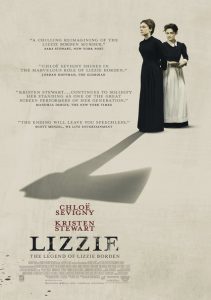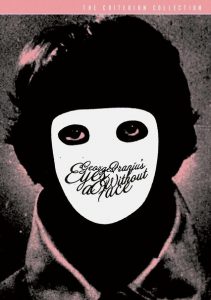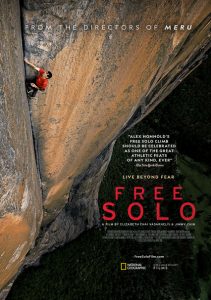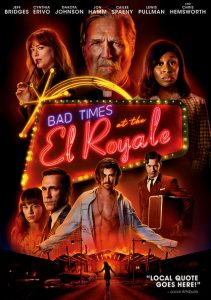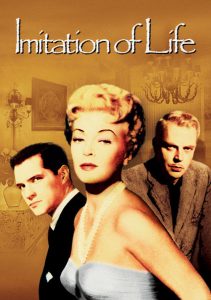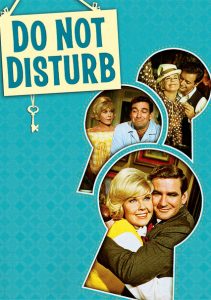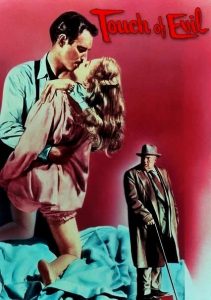Lizzie-2018
Director-Craig Macneill
Starring-Chloe Sevigny, Kristen Stewart
Scott’s Review #925
Reviewed July 31, 2019
Grade: B+
Lizzie (2018) is an odd and macabre interpretation of the life and times of the infamous Lizzie Borden, who was accused and acquitted of hacking her father and stepmother to bits with a deadly ax.
This offering is shrouded in a bit of controversy for inaccuracies and interpretations of the events, specifically Borden’s sexuality called into question. The film is quiet and a tad too slow but thunders to a grand climax more than making up for any negatives.
The casting of its leads is perfect and key to success.
Thirty-two-year-old Lizzie (Chloe Sevigny) lives with her domineering and affluent father Andrew, (Jamey Sheridan), and rigid stepmother, Abby (Fiona Shaw).
Despising both, she lives out a lonely and depressing existence with her only outlet being occasional evenings out at the theater. When an Irish immigrant, Bridget Sullivan (Kristen Stewart), moves into the Borden residence to work as a servant the women form a strong bond especially after she is abused by Andrew.
Sevigny, one of my favorite modern actresses, possesses a range that is astounding in the myriad of characters she has played in her long career.
Debuting to the masses in the critically acclaimed and depressing Boys Don’t Cry (1999) she has churned out a numerous array of independent features portraying one oddball character after another and deserves the strong influence she has achieved over the years.
Director, Craig Macneill makes interesting choices with his film which may or may not please audiences expecting a number’s horror offering. He dives into psychological thriller territory with more of a character study approach that provides layers to the finished product.
Sevigny is center stage and plenty of camera close-up shots offer an introspective analysis of what her feelings are rather than from her parents’ perspective. Instead of a crazed killer spontaneously committing the crime she is careful and calculating in her plan. Macneill presents Lizzie as the victim and Andrew and Abby as the villains.
This is to assume that Borden committed the crimes, which the film never doubts.
Historically, people assume that this is the truth, but Lizzie was set free by a jury refusing to believe a woman of such means would commit such a heinous crime. I wonder if Macneill directed the film with a bit of a smirk at this ridiculous decision of the times when the woman enjoyed the murders.
At the end of the film, it is explained what happened to Lizzie and Bridget which is a good decision and wraps the film into a nice tidy bow.
Powerful is the quiet subtext that gives a moody and foreboding quality. I adore slow-moving films provided the reward is worth the wait and Lizzie sucker punches once the events begin rolling along.
Another positive is the gnawing feeling of terrible things about to happen but unsure of when or how the attacks will occur. Most viewers choosing to watch this film will be aware of the context and the reported murders committed.
The atmospheric additions succeed as the late eighteenth-century costumes and daily living are believable. The lavish Borden house is well-kept and brightly lit offering a nice New England feel.
Finally, the creaks and noises throughout the house perfectly encompass the danger lurking behind corners and the fun is in wondering when Lizzie will strike.
Since the film moves back and forth through its time we know that strike she will.
Where the film offers its best work is through the relationship between Lizzie and Bridget. Sevigny and Stewart dazzle together with unleashed chemistry nearly rivaling a similar dynamic seen in 2003’s Monster.
As with Aline Wuornos and Selby, Wall Lizzie is the dominant one and Bridget is submissive following her lead. Both sets of women share a lesbian relationship and neither pair achieves any happiness after the film.
A film sure to fly under the radar and likely to be forgotten before long, Lizzie (2018) is worth the effort. A spooky and controversial interpretation of the events leading up to, during, and after one of the most notorious crimes in United States history is dissected and analyzed from a human perspective.
Macneill makes Borden less maniacal and more sympathetic than some may prefer. I think he does a fine job and deserves praise for a rich telling.
